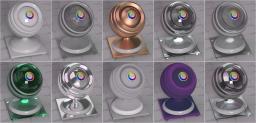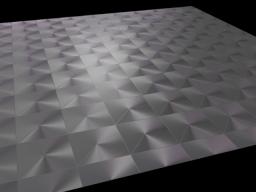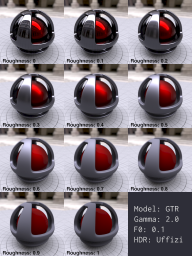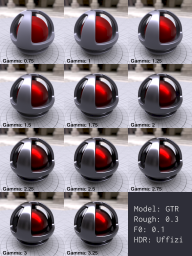Search the Community
Showing results for tags 'bsdf'.
-
Hi. After some research I developed the concept of the surface shader to make shading artist work more efficient. A while ago I have implemented it in VEX and now I want to share it with you. GitHub Features: PhySurface VOP Energy conserving surface model PBR and RayTrace render engines support GTR BSDF with anisotropy (also avaible as a separate VOP node) Conductor Fresnel Volume absorption Raytraced subsurface scattering Artist-friendly multiple scattering (also avaible as a separate VOP node) Ray-marched single scattering Translucency Dispersion Thin sheet dielectric Transparent shadows Extra image planes support Per-component image planes Per-light image planes Variance anti-aliasing support Layered material Nesting material PhyVolume VOP Color scattering and absorption Per-light image planes PhyShader v1.2.0 - download: This is usability release. BSDF has changed to GTR New artist-friendly SSS Added layer support Added metallic desaturation Improved dispersion Materials: Added PhySurface Layered material Added PhySurface Nested material Improved PhySurface material Viewport support UI: New Inside IOR presets menu Changed dispersion presets menu Numerous bugfixes
- 30 replies
-
- 17
-

-
- yet another surface shader
- pbr
-
(and 3 more)
Tagged with:
-
Hello. Since Houdini 12.5 and the addition of the cvex_bsdf() function the user base is no longer restricted to the confines of Phong and Blinn. While these models are tried and true over the past few years newer reflectance models have stepped into the spotlight (pun!), notably the ever so popular GGX. So for the lulz I implemented a variety of the newer ones and would like to share. Ultimately this is an incredibly huge topic and would take a significant amount of writing to explain all the fun bits so instead I'm going to link spam because I got TF2 to play. Background & Learning Physically Based Rendering for Artists (youtubez) Physically Based Specular for Artists Basic Theory of Physically-Based Rendering Cook-Torrance Model in Mantra Shader Microfacet BRDF (This is quite "mathy" but gives a nice overview of what is going on inside the Microfacet VOP) Disney BRDF (Disney's BRDF from Siggraph 2012, minimal parameters with a fair bit of flexibility. Required reading for the Disney VOP and also the GTR VOP) Siggraph 2010 Course Notes Siggraph 2012 Course Notes Siggraph 2013 Course Notes So with that all that background info out of the way on to the toys. In the attach OTL there are a few different VOPs, I've included a brief description here, but I actually (gasp) wrote documentation for each of the VOPs so I suggest you read them. Physically Based GGX (cvex) Microfacet BSDF with a GGX distribution, Schlick Fresnel, and Smith Masking. If you set the model to be "Distribution Only" it disables Fresnel and Masking and is purely just a distribution similar to how Phong, Blinn work. This model also supports anisotropic distributions. Physically Based GTR (cvex) A more generalized version of GGX. (GTR stands for Generalized Trowbridge & Reitz). In fact GGX == GTR when GTR's gamma parameter is 2. This is isotropic, Mathematica and I are still having a disagreement over possible anisotropic solutions. Physically Based Microfacet (cvex) This is everything and the kitchen sink. Its slower and not really meant for production cause it has all the options. But its good for exploring the various models and what they look like. Once a nice combination is found you'd would make a more dedicated and optimized version similar to the GGX/GTR ones above. You might get some fireflies with this for certain combinations as some of the formulas will converge on infinity faster than others. Generally the easiest way to fix it is to increase your Roughness G. The Roughness G parameter allows you to control the roughness Geometry Masking term independently of the distribution. Think of it as a multiplier for how much "micro-occlusion" you want. Disney (cvex) Direct port of the Disney BRDF. The parameters for this are suppose to be generally kept between 0 and 1 however I find the sheen to be way under powered when at a value of 1, so you might need to crank it to 11 to see it. Please read the help card for this VOP, there is some special sauce overriding functionality I added. Disney Mixer VOP for mixing collections of Disney BRDR parameters. (Or BSDFs) How My Versioning Works major.minor.hotfix.build Majors: are full rewrites and I'd be amazed if the look stays the same. Minors: are important changes that might affect the look but I'll try to avoid it as much as possible. Basically I'll only change the look if I'm fixing a flaw. Hotfix optional: is for cases where some bug that needed fixing but doesn't change the look. Build: Builds are the number of commits since the previous release object. These will go up during development and once a release is frozen the build will stop. These don't affect namespacing and only show up in the otversion. Reporting Issues If you have a issue/bug/question please ask, I (we) are using variants of these in production so there will be continued support. When asking tho I ask/plead that you post what version of the shaders you are using. That way I know exactly where to took. You can get this info by middle mousing on one of the VOP nodes or running 'opinfo' on it. For example- / -> opinfo /shop/vopsurface1/pbrdisney1pbrdisney1: Full Name: /shop/vopsurface1/pbrdisney1 Operator type: pbrdisney Version: 1.1.55 Branch: release-1.1 Date: 2014-08-06 Commit: 6fc9e7f All that version, branch, and commit info is music to my ears. (If nothing else, please provide the commit.) Obligatory Renders of Smooth Objects Both these wedges are of the GTR model. One with varying roughness, the other with varying gamma. (Gamma on the GTR model controls how fast the specular tail falls off.) OTLs There are two OTLs, both with the same shaders but one OTL has namespaces and versions on the type names the other one doesn't. If you are going to use these in production or what-not I recommend the namespaced version that way if there is an update later one they can live side by side. If you don't care and are playing just go for the non-namespaced one. All of this stuff currently sits in a private git repo on bitbucket, once everyone bangs on it a bit and I get everything rock solid I'll switch it to a public repo so others can contribute. v-1.2 (devel) bsdf-v1.2.otl bsdf_namespaced-v1.2.otl v-1.1.1 (stable) bsdf-v1.1.1.otl bsdf_namespaced-v1.1.1.otl v-1.1 (stable) bsdf.otl namespaced_bsdf.otl Release Notes: 1.2: Removed roughness masking remapping on the Disney BSDF. (Edges will reflect more light now.) 1.1.1: Workaround for Houdini LLVM bug #63368 Added an Ashikhmin Diffuse VOP which handles microfacet masking 1.1: Initial Public Offering Known Issues: Calculation of albedo needs some thought. Currently the albedo returned is the normalization factor for the distribution function. While this matches how phong() and blinn() are setup, it should instead return the full reflectivity over the hemisphere taking into account frensnel (and masking?).
- 84 replies
-
- 27
-

-
Hi guys I'm doing a BSDF mix in vops with a float attribute which is defined by an attribute transfer. but as you see in the image the mix between two shaders (sss and steel) is not correct despite the attribute is 0 or 1 for all points. can any one please explain to me the probable reason? is there an alternative way? Thanks in advance
-
Hi Guys , I would be curious to know if some of you would be interested to help me work on an Open Source Mantra Shader. There are actually some very cool PBR shaders right now like those one : http://forums.odforce.net/topic/18353-pbr-all-purpose-layered-shader/?hl=danylyon http://forums.odforce.net/topic/20682-bsdf-bonanza-ggx-microfacets-disney-brdf-and-more/ http://forums.odforce.net/topic/21673-physhader/ The problem is that the first 2 are not accessible in VOP , you can't modify them yourself and thus you are not 100% free. The last one is also very cool and will help me a lot to understand VEX more in depth. But i would like to work on a modular shading tool. base on a core BSDF that you would then layer to build complex material. Most shader are more UBER shader like the V-Ray MTL / Arnold Standard / MR MIA / Mantra Shader. But i would like to have something closer from what you have in Maxwell or Octane. Where you combine BSDF. I'm quite bad in complex math, but i guess by combining some brain power here on od force we could achieve something cool. So i would have some questions before starting to work. Q1 - what would be the most powerfull environment to develop a cool mantra shader ? - Material shader builder context inside houdini - CVEX shader builder context - external compile VEX code - external compile CVEX code Q2 - what would be the most elegant organisation to keep thing easy to read / maintain ? - full VOP node organisation - full VEX code organisation - a mix of VOP and VEX with inline code Q3 - what are the requirements if we want to be able to make it work in Reyes/Raytrace/PBR ? - does CVEX shaders work in all mode ? - how to emulate the compute lighting node in CVEX ? For the moment i was thinking to start to work with those : - Material Shader Builder Context - mix of VOP for utilities and Inline Code for core shading functions - VEX I would be glad to have as much advise and pov on the subject ! Cheers E









